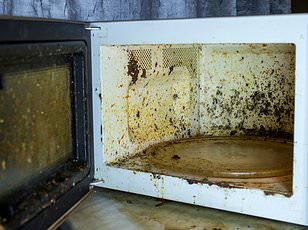The germs lurking in your SINK: Handbasins are hotspots for dangerous microbes that can cause pneumonia, Legionnaires' disease and wound infections, study warns
- Researchers analysed the microbes living in biofilms in hospital and home sinks
- They found bugs than can cause illnesses including pneumonia
It's often thought of as one of the cleanest spots in the home.
But a new study might have you scrubbing your sink extra hard this weekend.
Researchers from Flinders University have warned that handbasins are 'hotspots' for dangerous microbes.
Disgustingly, this includes bugs that can cause illnesses such as pneumonia, Legionnaires' disease, and wound infections.
And your sink isn't the only spot you need to worry about, as the study comes shortly after research revealed that radiation-resistant microbes can breed inside microwaves.

It's often thought of as one of the cleanest spots in the home. But a new study might have you scrubbing your sink extra hard this weekend (stock image)

Researchers from Flinders University have warned that handbasins are 'hotspots' for dangerous microbes. Disgustingly, this includes bugs that can cause illnesses such as pneumonia, Legionnaires' disease, and wound infections
Previous studies have discovered microbes living in a range of weird and wonderful habitats, including marine oil spills, industrial brownfields, and even inside the International Space Station.
But until now, it's been unclear which germs can fester in sinks.
To get to the bottom of this, the researchers analysed the 'biofilms' inside handbasins located in both hospitals and residential homes.
A biofilm is the slimy substance found on drains and around the faucet of handbasins.
Their analysis uncovered microbes living within the biofilms that can cause pneumonia, Legionnaires' disease, and wound infections.

The researchers analysed the 'biofilms' inside handbasins located in both hospitals and residential homes. A biofilm is the slimy substance found on drains and around the faucet of handbasins (stock image)
'In both settings we found a high abundance of pathogenic and corrosive germs, including some not typically carried in water,' said Claire Hayward, lead author of the study.
The researchers suggest that these pathogens are likely transferred to the biofilm from people using the sink for handwashing, from the incoming water supply, or via biological waste.
While you might think that the handbasins in hospitals would harbour more germs, surprisingly this wasn't the case.
'Residential handbasins have a more diverse bacterial community present on handbasin biofilms compared with hospitals,' said Dr Harriet Whiley, an author of the study.
'There was also a higher number of Legionella bacteria present in the residential samples compared with those taken from hospitals.'
Hospital sinks are likely cleaned more often and more thoroughly than sinks in the home, according to the team.
Ms Hayward added: 'The difference in the diversity of the microbial communities could be due to more regular cleaning, usage and the design of basins in hospitals through the implementation of healthcare infection control practices.
'This poses a risk to patients receiving healthcare in the home which has been emerging as an alternative to extensive inpatient hospital stays to reduce the burden on the healthcare system.'
Based on the findings, the researchers are urging people to regularly deep-clean their sinks.
'Patients receiving healthcare in the home need to be informed of infection control practices such as cleaning handbasin outlets and drains using effective disinfectants,' Ms Hayward concluded.



















































































































































































